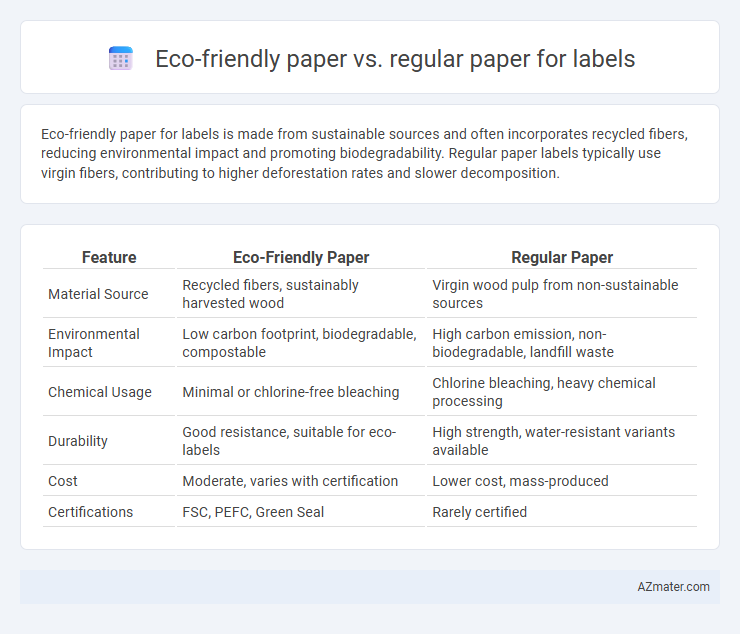Eco-friendly paper for labels is made from sustainable sources and often incorporates recycled fibers, reducing environmental impact and promoting biodegradability. Regular paper labels typically use virgin fibers, contributing to higher deforestation rates and slower decomposition.
Table of Comparison
| Feature | Eco-Friendly Paper | Regular Paper |
|---|---|---|
| Material Source | Recycled fibers, sustainably harvested wood | Virgin wood pulp from non-sustainable sources |
| Environmental Impact | Low carbon footprint, biodegradable, compostable | High carbon emission, non-biodegradable, landfill waste |
| Chemical Usage | Minimal or chlorine-free bleaching | Chlorine bleaching, heavy chemical processing |
| Durability | Good resistance, suitable for eco-labels | High strength, water-resistant variants available |
| Cost | Moderate, varies with certification | Lower cost, mass-produced |
| Certifications | FSC, PEFC, Green Seal | Rarely certified |
Introduction to Eco-Friendly and Regular Paper Labels
Eco-friendly paper labels are produced using sustainable materials such as recycled fibers, bamboo, or agricultural waste, minimizing environmental impact through reduced deforestation and lower carbon emissions. Regular paper labels typically rely on virgin wood pulp, contributing to higher energy consumption, increased greenhouse gases, and deforestation. Choosing eco-friendly paper labels supports sustainable forestry practices and promotes biodegradability, making them an ideal option for environmentally conscious brands.
Environmental Impact Comparison
Eco-friendly paper for labels significantly reduces environmental impact by using recycled fibers and sustainable sourcing, which decreases deforestation and lowers carbon emissions compared to regular paper made from virgin wood pulp. The production of eco-friendly labels typically involves less water consumption and fewer harmful chemicals, contributing to reduced pollution. Choosing recycled or FSC-certified paper for labels supports biodiversity conservation and aligns with eco-conscious brand values, minimizing waste through improved recyclability and biodegradability.
Manufacturing Process Differences
Eco-friendly paper for labels is produced using sustainable raw materials such as recycled fibers or agricultural residues, minimizing the use of virgin wood pulp. The manufacturing process employs chlorine-free bleaching and reduced water and energy consumption, resulting in lower environmental impact compared to the traditional paper production that relies heavily on chemical treatments and significant resource usage. This difference in manufacturing not only decreases carbon emissions but also supports circular economy principles by promoting material reuse in label production.
Material Composition and Sourcing
Eco-friendly paper labels use recycled fibers, agricultural waste, or bamboo pulp, reducing reliance on virgin wood and minimizing environmental impact. Regular paper labels typically consist of virgin wood pulp sourced from non-sustainable forests, leading to higher deforestation and carbon emissions. Sustainable sourcing certifications like FSC or PEFC are common in eco-friendly papers, ensuring responsible forest management and traceability.
Biodegradability and Recyclability
Eco-friendly paper labels are designed with high biodegradability, breaking down naturally within months without leaving harmful residues, unlike regular paper that often contains non-biodegradable coatings. These sustainable labels also offer superior recyclability due to their minimal chemical treatments, facilitating easier processing in recycling facilities. Choosing eco-friendly paper for labeling significantly reduces environmental impact through improved waste management and resource conservation.
Print Quality and Performance
Eco-friendly paper for labels often features a smoother surface and enhanced brightness, resulting in sharper print quality and vibrant colors compared to regular paper. Its engineered fibers improve ink absorption and durability, preventing smudging and fading during handling or exposure to moisture. Regular paper labels tend to have lower performance in print clarity and longevity, making eco-friendly alternatives the preferred choice for high-quality and sustainable labeling solutions.
Cost Implications for Businesses
Eco-friendly paper for labels often involves higher initial costs due to sustainable sourcing and manufacturing processes, but it can reduce long-term expenses through improved brand reputation and customer loyalty. Regular paper typically offers lower upfront prices, yet it may incur hidden costs related to environmental compliance or waste management. Businesses must weigh short-term savings against potential benefits like regulatory incentives and consumer preference for green products when deciding between eco-friendly and regular label paper.
Consumer Perception and Demand
Eco-friendly paper for labels is increasingly favored by environmentally conscious consumers due to its sustainable sourcing and biodegradability, driving higher demand in green markets. Studies indicate a growing preference for labels that reduce carbon footprints, enhancing brand reputation and customer loyalty. Regular paper, often associated with higher environmental impact, faces declining appeal as buyers prioritize eco-responsibility alongside quality and cost.
Regulatory and Certification Standards
Eco-friendly paper for labels complies with strict regulatory standards such as FSC (Forest Stewardship Council) and PEFC (Programme for the Endorsement of Forest Certification), ensuring sustainable sourcing and reduced environmental impact. Regular paper often lacks these certifications, raising concerns about deforestation and chemical usage according to EPA (Environmental Protection Agency) guidelines. Certifications like EU Ecolabel and ISO 14001 further validate eco-friendly labels' adherence to environmental norms and sustainable manufacturing processes.
Choosing the Right Paper for Sustainable Labeling
Eco-friendly paper for labels is made from recycled fibers or sustainably sourced raw materials, reducing environmental impact and promoting circular economies. It often features biodegradable or compostable properties that help minimize landfill waste compared to regular paper derived from virgin pulp. Selecting eco-friendly labels supports brand sustainability goals while maintaining print quality and durability needed for effective product identification.

Infographic: Eco-friendly paper vs Regular paper for Label
 azmater.com
azmater.com